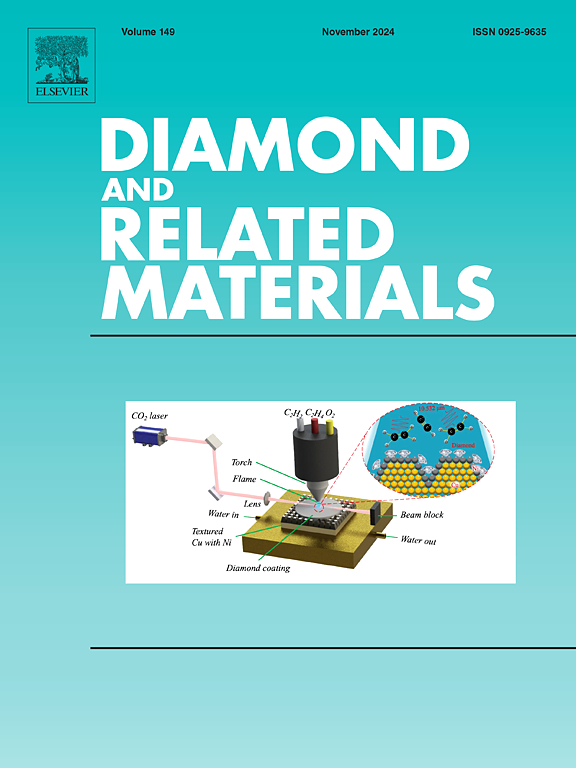Preparation and performance study of sodium silicate-diamond composite thermal management materials
IF 5.1
3区 材料科学
Q2 MATERIALS SCIENCE, COATINGS & FILMS
引用次数: 0
Abstract
Thermally conductive adhesives have become a significant research hotspot and have found broad applications in electronics and thermal management due to their excellent physical and chemical properties. However, the increasing demand for efficient heat dissipation in advanced electronics requires better adhesive performance. This study presents a novel inorganic thermally conductive adhesive using sodium silicate as the matrix and diamond micropowders as fillers. To enhance interfacial compatibility, diamond micropowders were surface-etched to increase surface area and functionalized with a silane coupling agent. Additionally, diamond micropowders with different sizes were blended in specific mass ratios to optimize performance, clearly demonstrating the systematic influence of diamond content on adhesive properties. The results clearly show that etching treatment of diamond micropowders enhances both the bonding performance and thermal conductivity of the adhesive. With increasing diamond content, the adhesive strength first increases and then decreases, reaching a peak at a filler mass fraction of 60 %. A similar trend was observed for the thermal conductivity, reaching a maximum at 50 % diamond content. The thermally conductive adhesive prepared with etched diamond micropowders exhibits a maximum tensile shear strength of 1.98 MPa and the highest thermal conductivity of 6.32 W·m−1·K−1. Furthermore, the thermal stability was improved, with the adhesive containing 80 % diamond micropowders losing only 2.06 % of its weight when heated from room temperature to 550 °C. Thus, we realize that controlling the content of diamond micropowders yields optimal bonding strength, improved thermal conductivity and excellent thermal stability, showing a greater potential for electronic thermal management.

硅酸钠-金刚石复合热管理材料的制备及性能研究
导热胶粘剂由于其优异的物理和化学性能,在电子和热管理领域有着广泛的应用,已成为一个重要的研究热点。然而,先进电子产品对高效散热的需求日益增长,需要更好的粘合剂性能。提出了一种以硅酸钠为基体,金刚石微粉为填料的新型无机导热胶粘剂。为了提高界面相容性,金刚石微粉被表面蚀刻以增加表面积,并用硅烷偶联剂进行功能化。此外,为了优化性能,我们将不同粒径的金刚石微粉按特定质量比混合,清楚地展示了金刚石含量对粘接性能的系统性影响。结果表明,金刚石微粉的蚀刻处理提高了胶粘剂的粘接性能和导热性能。随着金刚石含量的增加,粘结强度先增大后减小,在填料质量分数为60%时达到峰值。热导率也有类似的趋势,在金刚石含量为50%时达到最大值。刻蚀金刚石微粉制备的导热胶粘剂最大抗拉剪切强度为1.98 MPa,导热系数最高为6.32 W·m−1·K−1。此外,热稳定性得到了改善,当从室温加热到550℃时,含有80%金刚石微粉的胶粘剂仅损失其重量的2.06%。因此,我们意识到控制金刚石微粉的含量可以获得最佳的结合强度,改善导热性和优异的热稳定性,显示出更大的电子热管理潜力。
本文章由计算机程序翻译,如有差异,请以英文原文为准。
求助全文
约1分钟内获得全文
求助全文
来源期刊

Diamond and Related Materials
工程技术-材料科学:综合
CiteScore
6.00
自引率
14.60%
发文量
702
审稿时长
2.1 months
期刊介绍:
DRM is a leading international journal that publishes new fundamental and applied research on all forms of diamond, the integration of diamond with other advanced materials and development of technologies exploiting diamond. The synthesis, characterization and processing of single crystal diamond, polycrystalline films, nanodiamond powders and heterostructures with other advanced materials are encouraged topics for technical and review articles. In addition to diamond, the journal publishes manuscripts on the synthesis, characterization and application of other related materials including diamond-like carbons, carbon nanotubes, graphene, and boron and carbon nitrides. Articles are sought on the chemical functionalization of diamond and related materials as well as their use in electrochemistry, energy storage and conversion, chemical and biological sensing, imaging, thermal management, photonic and quantum applications, electron emission and electronic devices.
The International Conference on Diamond and Carbon Materials has evolved into the largest and most well attended forum in the field of diamond, providing a forum to showcase the latest results in the science and technology of diamond and other carbon materials such as carbon nanotubes, graphene, and diamond-like carbon. Run annually in association with Diamond and Related Materials the conference provides junior and established researchers the opportunity to exchange the latest results ranging from fundamental physical and chemical concepts to applied research focusing on the next generation carbon-based devices.
 求助内容:
求助内容: 应助结果提醒方式:
应助结果提醒方式:


